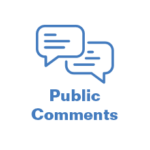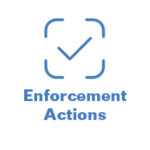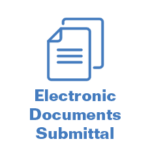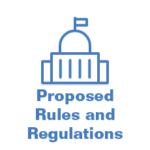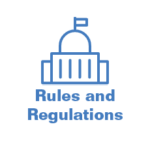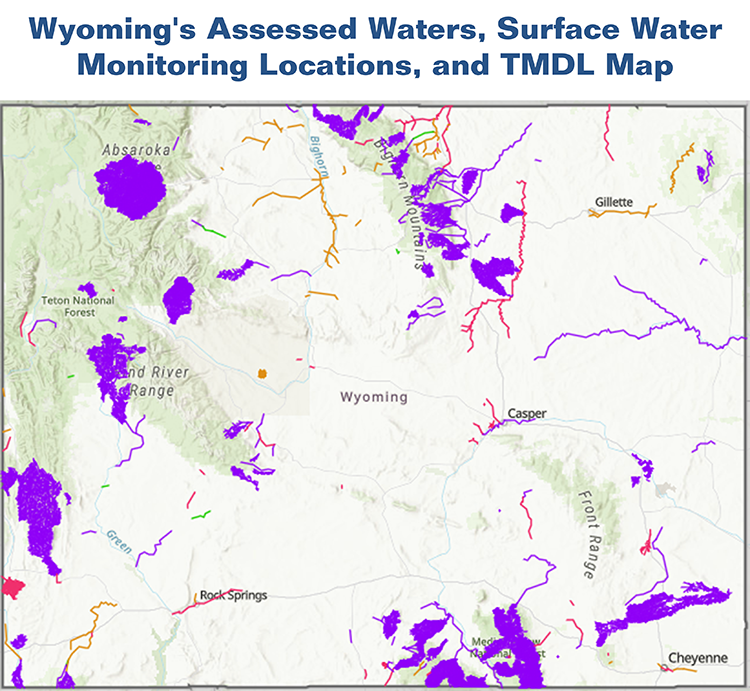- Home
- Public
- Resources
- Advanced Search
- Advisory Boards
- Careers
- District Offices
- e-Payment
- Enforcement Actions
- Meet the Director
- Mission Statement and Values
- Nondiscrimination Policy
- Outreach and Public Information
- Public Comments Online Portal
- Public Notices
- Records Requests
- Spill and Complaints
- State of the Environment
- Topics
- Divisions
- News
- Calendar
TMDL

The DEQ undertakes enforcement actions to preserve safe environmental conditions throughout Wyoming.
This page contains information on the enforcement actions that the Water Quality Division may undertake, as well as a record of enforcement actions that have been undertaken by WQD.
If the download box is not working below, please click here.
Electronic document submittal is available for WQD permit applications, reports, and other communications.
Visit: WDEQ Water Quality Division Downloads
You do NOT need to follow up the electronic submission with a hard copy submission unless you are specifically contacted by a WQD staff person with a request to do so.
Need to report a spill or complaint? Please visit https://deqspills.wyo.gov/home
Submitting a public comment? WQD is unable to accept public notice comments through this system. Refer to the public notice document for instructions on how to submit comments or visit https://wq.wyomingdeq.commentinput.com/comment/search.
NOTICE: All applications for water distribution systems and/or sewage collection systems that are within the Cheyenne Board of Public Utilities (BOPU) district shall be submitted to the BOPU for approval. Contact Frank Strong or Bryce Dorr at (307) 637-6460, ENGreview@cheyennebopu.org, or http://cheyennebopu.org for additional information.
The DEQ Water Quality Division accepts comments on all permits authorized under a general permit for a period of 30 days, as provided for in W.S. 35-11-801(d).
Interested persons may mail or fax comments to the main Cheyenne office. The ‘Date’ column in the table below indicates the date the authorization was posted to the website. Comments must be received before 5:00 pm on the 30th day after the authorization was posted to the website. For example, comments for an authorization posted on 10/1/18 must be received by 5:00 p.m. on 10/31/18. DEQ does not accept emailed comments.
You may sort the table by posting date or search for the type of general permit, the county where the permit was issued, the permit number, or the name of the person or company to whom the permit was issued.
If you wish to review the general permit documents, please go to the web page for each permitting program:
- Storm Water Construction, Mineral Mining, and Industrial General Permits.
- Underground Injection Control (UIC) General Permits
- Water and Wastewater Construction General Permits.
- WYPDES General Permits
If the download box is not working below, please click here.
All official Wyoming State Rules and Regulations are kept at the Wyoming Secretary of State’s Office. Click here to view all current Rules and Regulations.
TMDL
States are required to develop total maximum daily load (TMDL) pollutant levels for waterways that are not adequately meeting federal Clean Water Act water quality standards.
What is a Total Maximum Daily Load (TMDL)?
TMDLs are a requirement of Section 303(d) of the Clean Water Act (CWA). According to the CWA, each state must develop TMDLs for all the waters identified on their Section 303(d) list of impaired waters. A TMDL is a calculation of the maximum amount of a pollutant that a waterbody can receive while still meeting water quality standards. An overview of TMDLs is provided on EPA’s website. Simply, a TMDL is a plan to achieve water quality standards for impaired waterbodies.
In general, states are responsible for developing TMDLs and submitting them to EPA for approval. Even if third parties assist in the development of the TMDL or its supporting analysis, such TMDLs must still be submitted to EPA by the states.
Under the CWA, the EPA reviews and either approves or disapproves the TMDL. If EPA disapproves a state TMDL, EPA must develop a replacement TMDL.
The Process
The TMDL Program coordinates with several other DEQ programs including the Monitoring, Assessment, Permitting, and Nonpoint Source Programs to accomplish water quality restoration goals in Wyoming. TMDLs are one step in the “water quality restoration pipeline”.
The process begins when a waterbody is placed on the 303(d) list due to an exceedance of one or more water quality standards. Once an impaired water is placed on the 303(d) list, water quality restoration planning begins.
The TMDL is the planning step in the process where sources of pollution to streams, rivers, and lakes within Wyoming are identified and it is determined by how much pollution those waters can sustain and still fully support beneficial uses.
TMDLs are not self-implementing. Rather, TMDLs are implemented through existing regulatory and non-regulatory drivers. Point sources of pollution are addressed through the Wyoming Pollution Discharge and Elimination System (WYPDES) permit program. Federal regulations require that discharge permit limits be consistent with the assumptions and requirements of any available wasteload allocation in approved TMDLs (40 CFR 122.44(d)(1)(vii)(B)). Non-point sources load reduction actions are implemented through a wide variety of programs at the state, local and federal level. These programs may be regulatory, non-regulatory or incentive-based (e.g., a cost-share program). Wyoming works closely with conservation districts and watershed stakeholders through voluntary actions, often with support from Wyoming’s Nonpoint Source Program using Clean Water Act Section 319 and 205(j) grant funds for projects aimed at reducing the nonpoint source pollution.
Follow-up monitoring to examine water quality trends over time, and BMP effectiveness monitoring to evaluate the efficacy of implemented best management practices, are important components of the process. Achieving the ultimate goal of meeting the applicable water quality standards often takes many years and follow-up monitoring data can both facilitate and inform adaptive management actions, and track progress over time. Much of the follow-up monitoring in Wyoming is conducted by watershed stakeholders with technical support provided by WDEQ.
| NAME/EMAIL ADDRESS | PROGRAM | PHONE |
| David Waterstreet, Program Manager | Watershed Program | 307-777-6709 |
| Clean Water Act (CWA) Section 401 Certification and Turbidity Waivers | ||
| James Tarzon (Cheyenne) | CWA Section 401 Certification, Turbidity Waivers | 307-777-6701 |
| Data Quality Assurance and Quality Control (QA/QC) | ||
| Jillian Scott (Cheyenne) | Data QA/QC | 307-777-6372 |
| Surface Water Monitoring Program | ||
| Jeremy Zumberge, Program Supervisor (Sheridan) | Surface Water Monitoring Program | 307-675-5638 |
| Tavis Eddy (Lander) | Surface Water Monitoring Program | 307-335-6957 |
| Vacant (Cheyenne) | Surface Water Monitoring Program | |
| Vacant (Sheridan) | Surface Water Monitoring Program | 307-675-5632 |
| James Tarzon (Cheyenne) | Surface Water Monitoring Program | 307-777-6353 |
| Vacant (Sheridan) | Surface Water Monitoring Program | 307-675-5637 |
| Michael Wachtendonk (Lander) | Surface Water Monitoring Program | 307-335-6751 |
| Surface Water Quality Standards | ||
| Eric Hargett, Program Supervisor (Cheyenne) | Surface Water Quality Standards | 307-777-7079 |
| Rachel Eyres (Cheyenne) | Surface Water Quality Standards, Harmful Cyanobacterial Blooms | 307-777-2073 |
| Tori Nye (Cheyenne) | Surface Water Quality Standards, National Environmental Policy Act (NEPA) | 307-777-7050 |
| Total Maximum Daily Load (TMDL)/Assessment/ Nonpoint Source Pollution/Program | ||
| Ron Steg, Program Supervisor (Lander) | Total Maximum Daily Load (TMDL) | 307-335-6980 |
| Joanna Harter (Lander) | Total Maximum Daily Load (TMDL) | 307-335-6965 |
| Mackenzie Hairfield (Cheyenne) | Nonpoint Source Program Coordinator | 307-777-6733 |
| Water Quality Lab | ||
| Steve Vien, Lab Supervisor (Cheyenne) | Water Quality Lab | 307-777-7654 |
| Rex Bagley (Cheyenne) | Water Quality Lab | 307-777-7151 |
| Amaryllis Briggs (Cheyenne) | Water Quality Lab | 307-777-6783 |
| Alexis Lester(Cheyenne) | Water Quality Lab | 307-777-3770 |
This page is under development.
This page contains links to all of the completed and approved TMDL documents. Links to TMDLs for individual waterbody segments are provided in the interactive TMDL and Assessment Map.
This page is under development.
Click on the map below to access Wyoming’s Assessed Waters, Surface Water Monitoring Locations, and TMDL Map. This web map provides access to:
- summary information about each of Wyoming’s lakes and streams that have been assessed against Wyoming’s water quality standards,
- monitoring locations and links to data request portals,
- and watersheds for which TMDLs have been completed.



